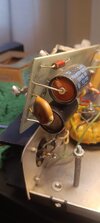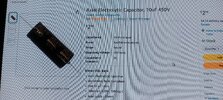This has a 6JU6, which is what the schematic (that I downloaded) shows ot should be. I googled it and it says to be a Beam Power Tube. Sounds good to me. It is definitely antique/vintage and shows about the same wattage as the TX-75 does (on my scrappy meter of course). Seems like I heard one time " about 100w per tube" and "25-30w per pill. Does this sound right?
You are using an out of date browser. It may not display this or other websites correctly.
You should upgrade or use an alternative browser.
You should upgrade or use an alternative browser.
-
You can now help support WorldwideDX when you shop on Amazon at no additional cost to you! Simply follow this Shop on Amazon link first and a portion of any purchase is sent to WorldwideDX to help with site costs.
Kris 300M
- Thread starter DelR
- Start date
Plate dissipation for that tube is 17 Watts. For an amplifier with roughly 50 percent efficiency, you'll throw one Watt of heat to the two tubes' plates for every average Watt of RF output.This has a 6JU6,
Round it up to 35 Watts average output from the thing, and with 100% modulation that would be 140 Watt peaks.
More or less what I expect to see from one of those, a 30 Watt (or so) carrier with at least 120 Watt peaks, typically more.
Back in the day, a 23-channel radio with a 3-Watt carrier would get a roughly ten-to-one power gain from one of these.
Assuming, of course, that you can stand the squeal noise from the high-voltage converter.
73
I have one I put new caps in,
Thanks for making me think here. Looks like both 10uf 450v caps are bad. These are 1950 version, so, new ones can be expected to be a little smaller in physical size, correct? I see them on Amazon and are smaller.I have one I put new caps in, fun little box.
Attachments
The way this was explained to me has to do with the high cost of aluminum in Japan. If you can use less of it in your capacitors, your manufacturing cost drops, gives you an advantage over competitors.
Milling aluminum foil ever and ever thinner is what caused aluminum electrolytics to shrink decade by decade since the 60s and 70s. The japanese perfected this as a competitive advantage.
American made caps had no such incentive. Aluminum was cheaper in the USA than elsewhere in the world for a long time.
73
Milling aluminum foil ever and ever thinner is what caused aluminum electrolytics to shrink decade by decade since the 60s and 70s. The japanese perfected this as a competitive advantage.
American made caps had no such incentive. Aluminum was cheaper in the USA than elsewhere in the world for a long time.
73
Sounds right to me, thanks.The way this was explained to me has to do with the high cost of aluminum in Japan. If you can use less of it in your capacitors, your manufacturing cost drops, gives you an advantage over competitors.
Milling aluminum foil ever and ever thinner is what caused aluminum electrolytics to shrink decade by decade since the 60s and 70s. The japanese perfected this as a competitive advantage.
American made caps had no such incentive. Aluminum was cheaper in the USA than elsewhere in the world for a long time.
73



